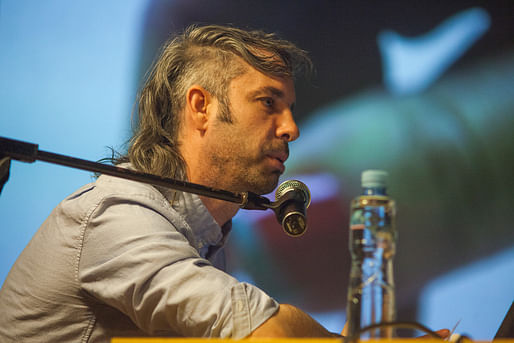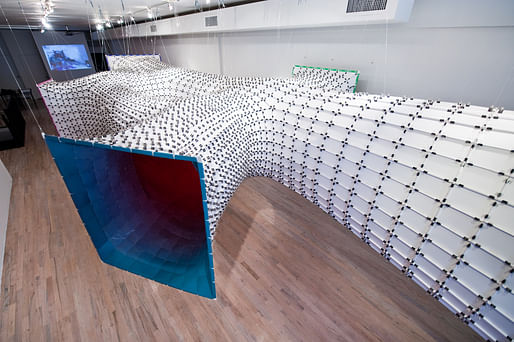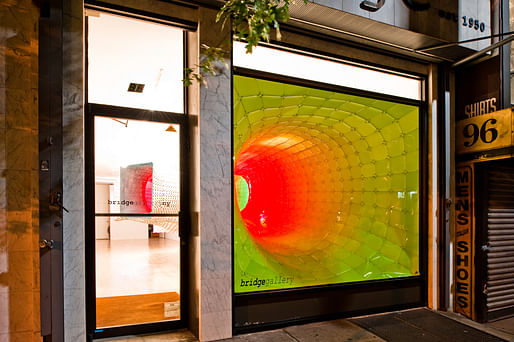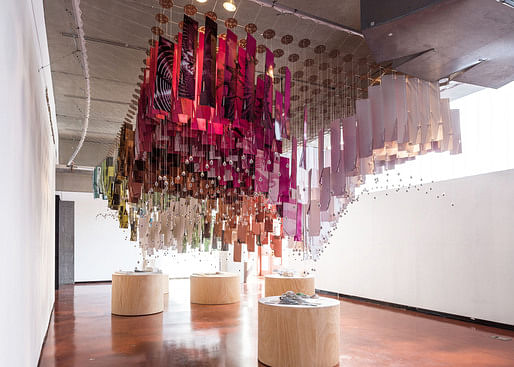
 Recently, Modelo spent some time meeting with Michael Szivos the founder and principal of SOFTlab at his design studio in Manhattan. Szivos spoke about his firm’s approach to design the issues he sees with design software and the future of his firm.
Recently, Modelo spent some time meeting with Michael Szivos the founder and principal of SOFTlab at his design studio in Manhattan. Szivos spoke about his firm’s approach to design the issues he sees with design software and the future of his firm.
On the beginnings of SOFTlab
Well the short story is that I had just graduated from grad school at Columbia’s GSAPP and like everyone else I needed to get a job. I had worked in the city before so right as I was getting all of my work together portfolio and resume, people I had worked with in the past just started calling about doing freelance work. So that summer I did a lot of freelance work. A lot of it was working with friends and other architects but some of it was also working with artists. One of the projects with an artist was basically helping them with any kind of digital content from helping them figure out how to fabricate their installations and sculptures to creating video. And one of those turned into a pretty large project where we had to set up a space to complete it and basically that turned into the office. So in the beginning we were doing a lot of work for artists and the space we were in had a lot of other artists so we became the guys that helped them with their digital work.

Photograph by Alan Tansey couretesy of SOFTlab
On the name “SOFTlab”
The name of our office came from a pretty romantic idea about what an office could be. We had just graduated from school and thought we could start an office that produced work through a focus on experimentation. That’s where the “lab” part came from. The “SOFT” came from the idea that we didn’t want a large office, but a group of smaller more versatile designers who could tackle any problem. In this sense, the office would be malleable and able to reform itself based on any brief or problem. Together that makes “SOFTlab.” So far it has worked well. There are the obvious jokes, and occasional calls of someone looking for a clinic or medical lab. I don’t think about the name so much anymore, but it does serve as a register of whether we have stayed or enforced our initial intentions. For the most part we have taken a variety of projects that have required skills outside of architecture and we have continued to experiment through real work. I am proud of that.
On the tools they use
We mostly use Rhino and Grasshopper. Before Grasshopper we used things like maya where we would create custom code and things like that. That’s kind of where we started. Now almost everything is done with Rhino and Grasshoppper. The main thing with a lot of these projects is developing two things. One developing the project itself and two developing the system which actually produces the project. A lot of the projects go direct to manufacturing whether it’s a laser cutter or a fabricator there’s no real shop drawings. Now we produce shop drawing packages because we work with larger teams. But those are mostly to give an understanding of what’s going to happen. A lot of this stuff is about building tools that take things directly to manufacturing.

Photograph by Alan Tansey courtesy of SOFTlab
On Design Reviews
I’m very adamant about people being prepared. We’re not going to show anything to a client unless it’s produced but I just feel like if you draw something it means that you as person who is part of a larger group, that means you have to edit things down already because you have to commit to that drawing, that thing. That’s one of the biggest challenges here in the studio and has become a bigger challenge in school. If someone does eight screen grabs or renderings that are just pictures of a thing, they have yet to commit to it. They have yet to edit it down. They’ve yet to think about how they would choose one versus the other. That to me is the biggest problem in design today. It’s just so easy to produce an image and I’m not someone who says you need to draw by hand, but the fact that we can just do screen captures has erased the commitment and editing within the profession. Here in our office I’m always asking, “Are you showing me this thing because you’ve committed to this? Or do we need to talk about this?”
…Our work definitely has some formal qualities but for me it’s mostly about material, experience, effect, and engagement.
On being an educator and a practitioner
I teach at Pratt and at Yale in the fall. For me it’s great. There are moments when it feels like a second job and that’s when the students may not be producing as interesting work as you’d like but it’s really good. I don’t see the difference in the two. For me the first priority is the practice and teaching has kind of developed out of that. A lot of what we do here makes its way into school because someone will ask me to teach what we’re doing here in school. And vice versa, what’s happening in school will find its way into the studio. But a lot of the stuff like the research and development in grasshopper is in some cases pretty high level and that happens here more than in school, which is kind of different. But in general the things are closely linked. A lot of people in the studio,teach which is highly encouraged. I think it’s a good thing for people to form their agendas and learn how to speak with people and present their position towards that agenda.

Photograph by Alan Tansey courtesy of SOFTlab
On the limitations of design software
We’re the kind of studio that when we run into issues with a software, we make our own tools. In the past that’s been one of the big challenges and one of the fun parts of doing this kind of work but now it’s a bit easier with things like Grasshopper. We’re doing a lot of interactive installation work now, so we’re writing tools and applications which take things in directly from Rhino so we can take a client through a model which has interactive capabilities, which is pretty cool. We figure it out.
On client development
We mostly get clients who just call us. I’ve never really done any new business. But we’ve also transitioned where we do bigger projects now. We used to do a lot of web and video work but we don’t really do that anymore. That’s kind of how we started doing websites for friends something we could do immediately and make money to get the studio going. Although all our friends were architects who had no money so umm (laughing). Those were smaller projects that would fill in the gaps but we don’t really do those anymore, which is great for me. Managing a lot of small projects ismuch more time consuming than managing a couple big projects and the amount of money you end up making is the same. So we’re doing big projects, but when those fall through it has more consequences. We’ve recently started doing what I would consider bigger projects and I’ve realized we need two or three of thoegoing on at any given time.
My plan, whether it’ll work or not is that we do a lot of work with agencies. Everyone likes to think they’re really talented and that’s why people come to you but the reality is that’s just why you’re on a certain list. At the end of the day it’s just whoever’s name is on the tip of someone’s tongue. We are also happy to take on projects that don’t require a really overt design, and that’s really good for the studio because we don’t need to go through a heavy-handed design phase. Some of the methods we go through with our more complex projects are helpful for those agency projects where you need to build something out of parts that can go together very quickly in one day for an event.
I’m very much a person where if I meet with a client on a design proposal I want to meet with them in-person if possible. Same with talking about our work. After that it can be any combination of sending a PDF or whatever the case may be. When I’m out at events or openings I end up meeting people and projects come through in those ways. I’d love to have someone else do new business but they may not have the same kind of commitment to the work, which I think makes sense, so as far as new business right now the best person to talk about it is me.

Photograph by Alan Tansey courtesy of SOFTlab
On SOFTlab’s unique approach
I think in the beginning it was very reactionary. I came from Columbia which is a very digital kind of school. There were a lot of guys doing things I was interested in. It’s not that I didn’t like their work but the way that school works is that people develop certain camps, which I’m not really into. I think our work was a reaction to us being put in categories I didn’t think we aligned with. Especially as far as tools. I enjoyed using digital tools, but I didn’t like how the tools we used might frame the outcome of our work. Our work definitely has some formal qualities but for me it’s mostly about material, experience, effect, and engagement.
We definitely use digital tools but we sit down and we come up with an idea and we try to come up with it outside of architecture so it’s not limited to what people already think of architecture as. It’s very much about making things and being inventive. We always try to avoid a style but we do have some things we continue to develop and sometimes they overlap and get mixed together. A client might come to us because of our work but we’re happy to make that client part of that process. For me it’s difficult to work without the client because they’re such a central part of how we develop an idea.
On the future of SOFTlab
I would like to continue the work that we’re doing. I wouldn’t mind doing more retail and office space design. From the work that we’ve done and the people we’ve worked with where we’ve built something that is part of the strategy of the client’s company even an extension of that strategy is interesting to me. How do you bring design into a project as a commodity? I’m not so interested in this idea that designers are geniuses and we need patrons. I think design has a huge amount of tangible value and in general the world would be a better place when not just clients but regular people, consumers feel it has value too. That’s the kind of work we’re doing now, bespoke projects for big brands that want to connect to their customers with something interesting. There seems to be a movement towards brands working with artists or designers that do very specific things and they ask you to do your thing.
At Modelo we want to know what drives the world’s design and architecture talent. This is why we invite select architects and designers to share their stories, philosophies, visions and favorite works with the public — their manifestos. For more information on how we're working to change the architecture and design world at Modelo please visit us at: www.modelo.io.
No Comments
Block this user
Are you sure you want to block this user and hide all related comments throughout the site?
Archinect
This is your first comment on Archinect. Your comment will be visible once approved.